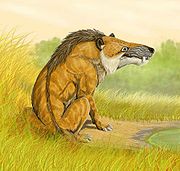
Triisodontidae
Encyclopedia

Family (biology)
In biological classification, family is* a taxonomic rank. Other well-known ranks are life, domain, kingdom, phylum, class, order, genus, and species, with family fitting between order and genus. As for the other well-known ranks, there is the option of an immediately lower rank, indicated by the...
of mesonychian placental mammal
Mammal
Mammals are members of a class of air-breathing vertebrate animals characterised by the possession of endothermy, hair, three middle ear bones, and mammary glands functional in mothers with young...
s. Most triisodontid genera lived during the early Paleocene
Paleocene
The Paleocene or Palaeocene, the "early recent", is a geologic epoch that lasted from about . It is the first epoch of the Palaeogene Period in the modern Cenozoic Era...
in North America
North America
North America is a continent wholly within the Northern Hemisphere and almost wholly within the Western Hemisphere. It is also considered a northern subcontinent of the Americas...
, but the genus Andrewsarchus is known from the late Eocene
Eocene
The Eocene Epoch, lasting from about 56 to 34 million years ago , is a major division of the geologic timescale and the second epoch of the Paleogene Period in the Cenozoic Era. The Eocene spans the time from the end of the Palaeocene Epoch to the beginning of the Oligocene Epoch. The start of the...
of Asia
Asia
Asia is the world's largest and most populous continent, located primarily in the eastern and northern hemispheres. It covers 8.7% of the Earth's total surface area and with approximately 3.879 billion people, it hosts 60% of the world's current human population...
. Triisodontids were the first relatively large predatory mammals to appear in North America following the extinction of the dinosaur
Dinosaur
Dinosaurs are a diverse group of animals of the clade and superorder Dinosauria. They were the dominant terrestrial vertebrates for over 160 million years, from the late Triassic period until the end of the Cretaceous , when the Cretaceous–Paleogene extinction event led to the extinction of...
s. They differ from other mesonychian families in having less highly modified teeth.
Because of their comparatively simpler teeth, the Triisodontids are regarded as basal mesonychids. Some experts regard the Triisodontids as being condylarth
Condylarth
Condylarthra is an order of extinct placental mammals known primarily from the Paleocene and Eocene epochs. Condylarths are among the most characteristic Paleocene mammals and they illustrate the evolutionary level of the Paleocene mammal fauna....
s, or even arctocyonid
Arctocyonidae
Arctocyonidae is an extinct family of unspecialized, primitive mammals with more than 20 genera most abundant during the Paleocene, but extant from the late Cretaceous to the early Eocene ....
s, rather than mesonychids proper.

